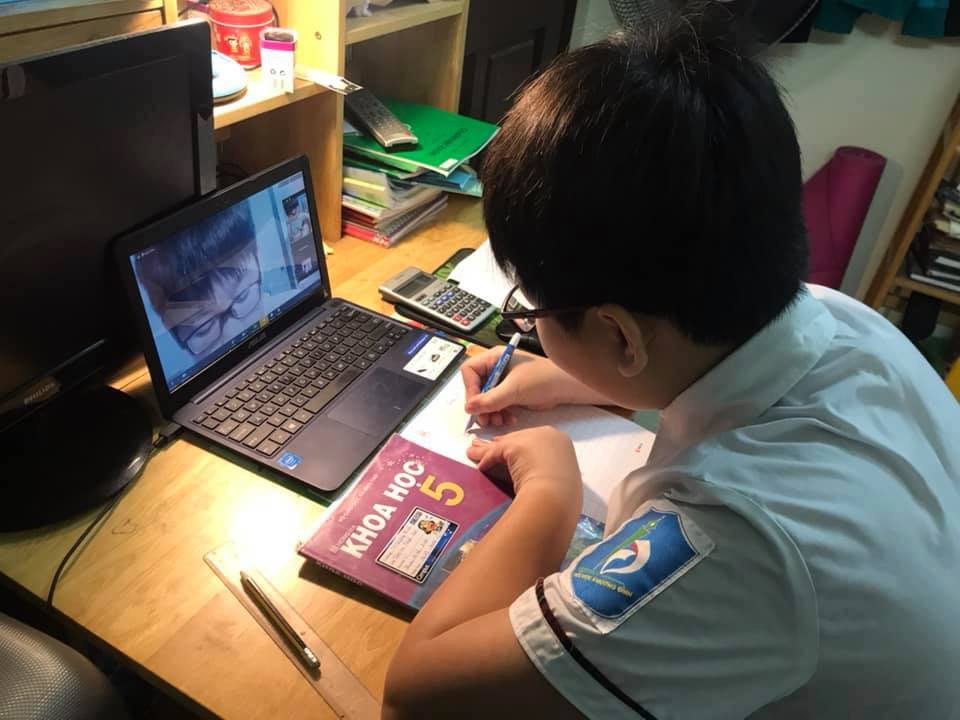While the novel coronavirus disease (COVID-19) pandemic continues to push schools toward moving their classes online, many parents worry that the benefits of distance learning fall far short of what can be achieved in a traditional classroom.
Hoping to make up for lost time brought about by more than two months of nationwide school closures, schools throughout Vietnam have spent the past week migrating their entire curricula online.
Now, as the novelty of distance learning quickly fades, parents who started the week excited for their children to be learning are battling headaches brought on by a slew of technical problems and equipment costs.
Poor execution
It took just one week before Minh Khuyen, the parent of two elementary school children in Thanh Xuan District, Hanoi, finally admitted that she was worn out from helping her kids manage their online studies.
According to Khuyen, her children need to print out an average of five worksheets per day to fulfill their teachers’ requirements.
On some days, particularly when math and Vietnamese lessons are involved, she said, that number stretches into the dozens.
“Ironically, printing requires paper and ink, but all stationery stores are closed because of the epidemic,” Khuyen said.
Zoom, the video conferencing platform adopted by the vast majority of Vietnamese schools, has also opened up a pandora’s box of issues on its own.
Though public school class sizes can reach up to 60 students per class, the free version of Zoom limits video conferencing to a maximum of 40 participants.
Consequentially, hundreds of students across the country find themselves 'locked out' of their virtual classrooms each day.
“Just yesterday, many parents in our group chat were complaining that they still couldn’t log their children in to the system at 8:40 am when the class had already started at 8:00 am,” said Khuyen, adding that her children’s experiences with Zoom include countless video freezes, shaky audio connections, and forced disconnections during class.
N.H.A., the mother of a fifth-grader in Hanoi’s Dong Da District, echoed Khuyen’s sentiment.
Because of back-to-back classes set to begin and end right after each other, teachers often show up late due to the time it takes them to switch between classes.
That, coupled with technical difficulties and waiting for every student to join, often leads to lessons beginning up to 20 minutes late.
“Poor audio and image quality combined with stuttering video streams affected my child’s learning experience,” A. complained.
Even when they are not dealing with technical issues, many still find themselves struggling with the burden of guiding their children through subjects they are simply not equipped to.
Art and PE classes, for example, seem to be the bane of many parents in Vietnam who find it hard to help their kids with prerecorded art tasks or exercise routines.
The cost of education
A full armory of online learning equipment — a PC, speaker, headphones, and printer — can set a family back at least VND10 million (US$425).
Families with multiple children are often forced to scrape together enough money to buy double or even triple the amount of equipment so their children can attend classes at the same time.
“Every parent wants to invest in their children’s education, but how can we afford a new computer and printer if we can’t even feed ourselves?” asked H.T., a parent from Thanh Xuan District whose child is making do with a budget smartphone.
Tran Thuy Lan, a hairdresser from Thanh Xuan, said that her third-grade daughter is studying from a smartphone.
“Even if we had a computer, I still probably wouldn’t be able to figure out how to download and print materials,” said Lan, a self-proclaimed technology-novice.
According to Khuyen, many of the students in her children’s classes attend via smartphone, likely because they do not have a PC or laptop available.
Unfortunately, it also means their experience is limited by the inability to make out texts on a teacher’s shared screen on such a small device.
Duong Dinh Nam from Hanoi’s Ung Hoa District also voices his concerns, stating that his own inexperience impedes his ability to help his child log in to class on the computer.
The poor communications infrastructure and lack of computer stores in his area only add to the difficulties.
On top of that, Vietnam's supply of online learning equipment is drying up as parents scramble to scoop what is left while imports from China remain throttled.
Like us on Facebook or follow us on Twitter to get the latest news about Vietnam!


















































